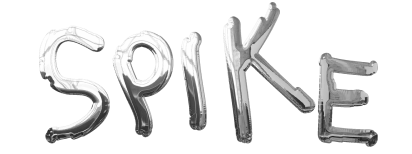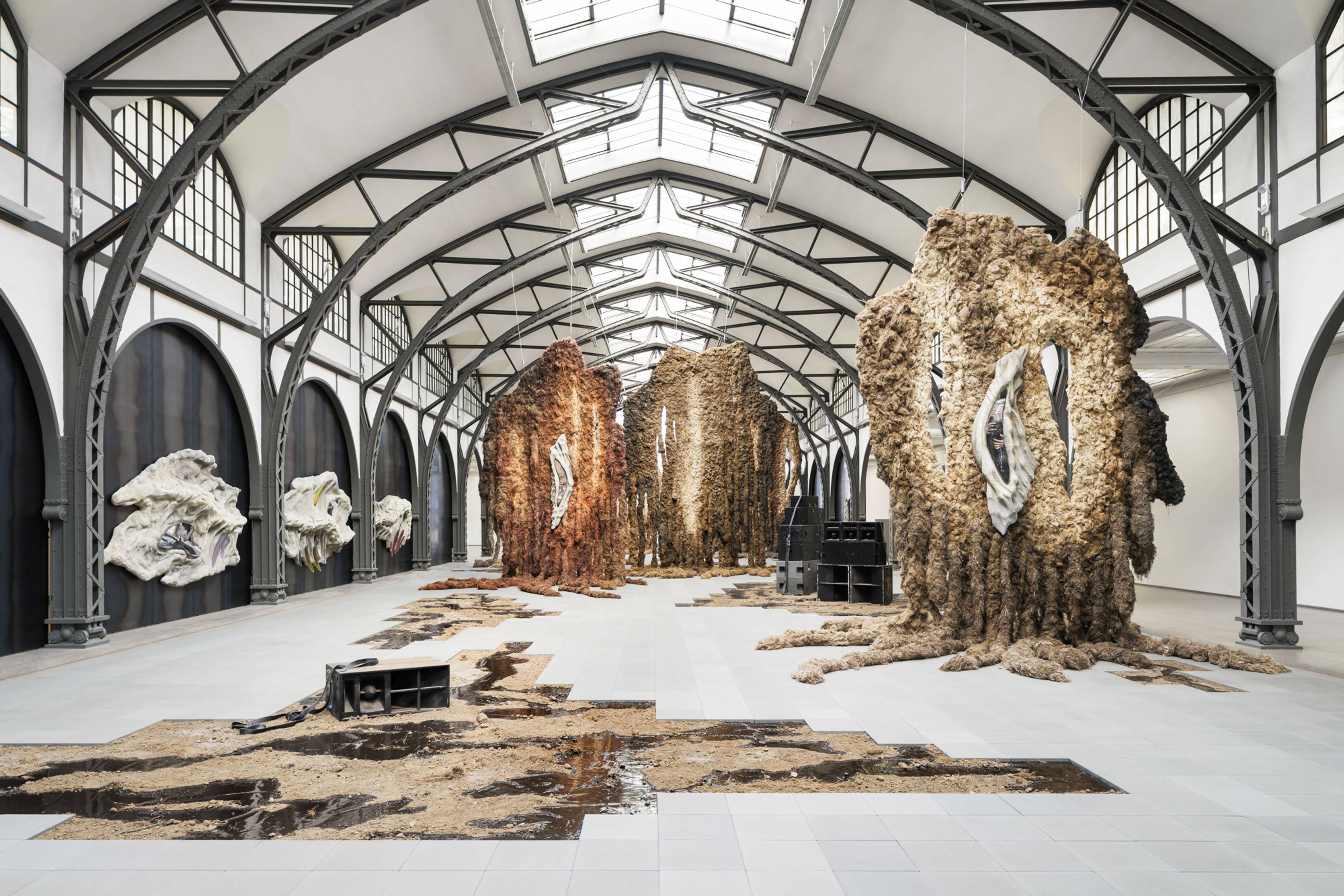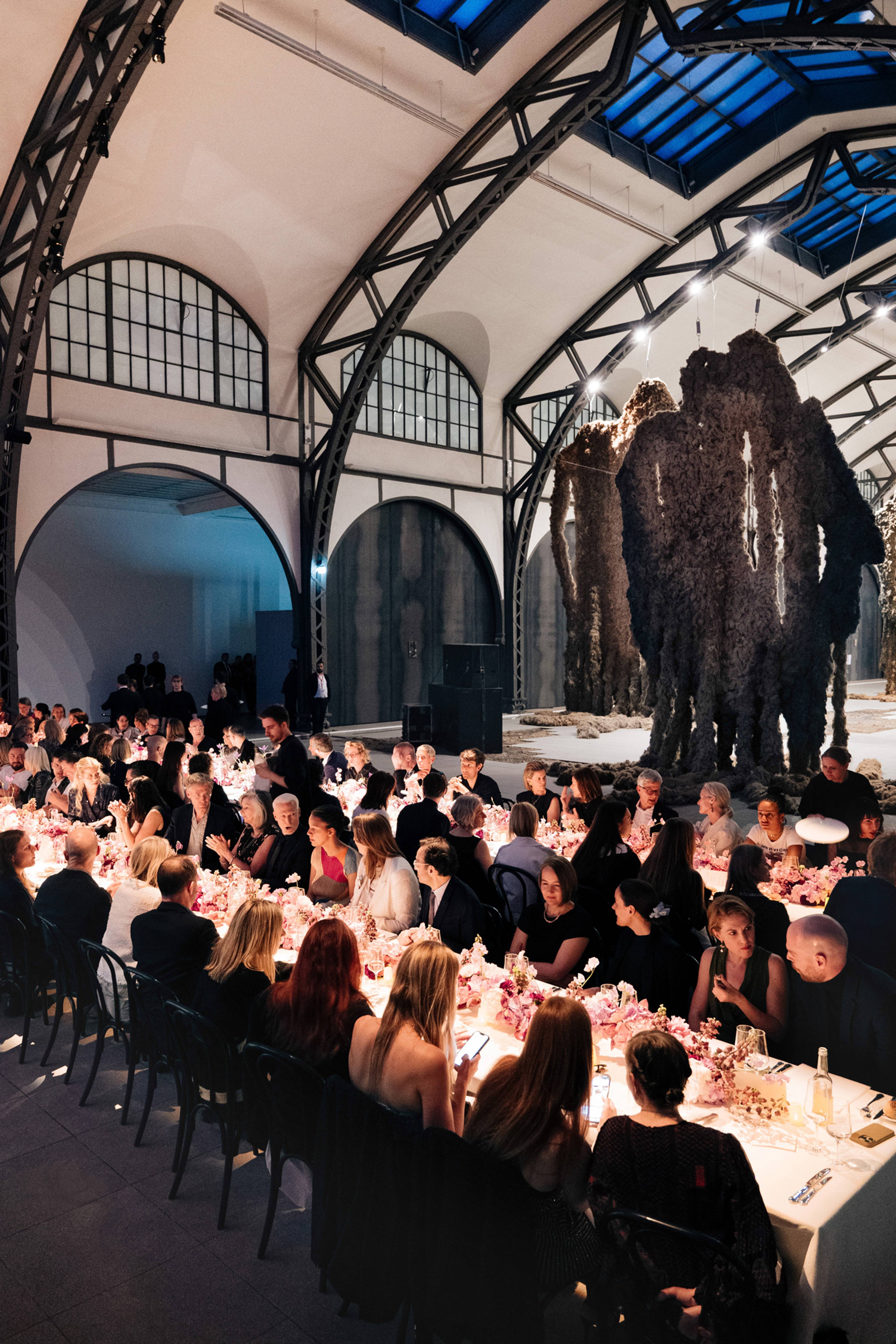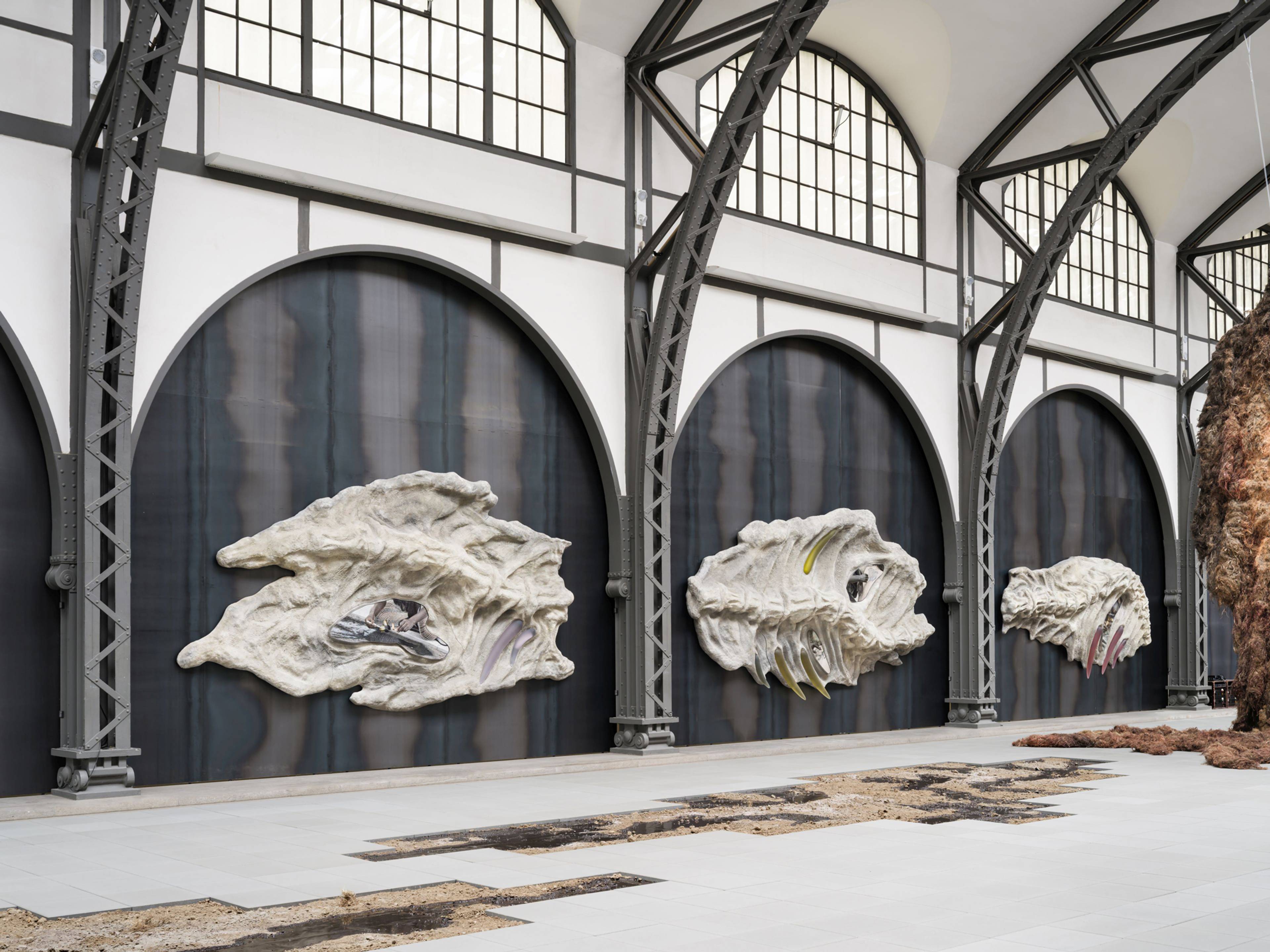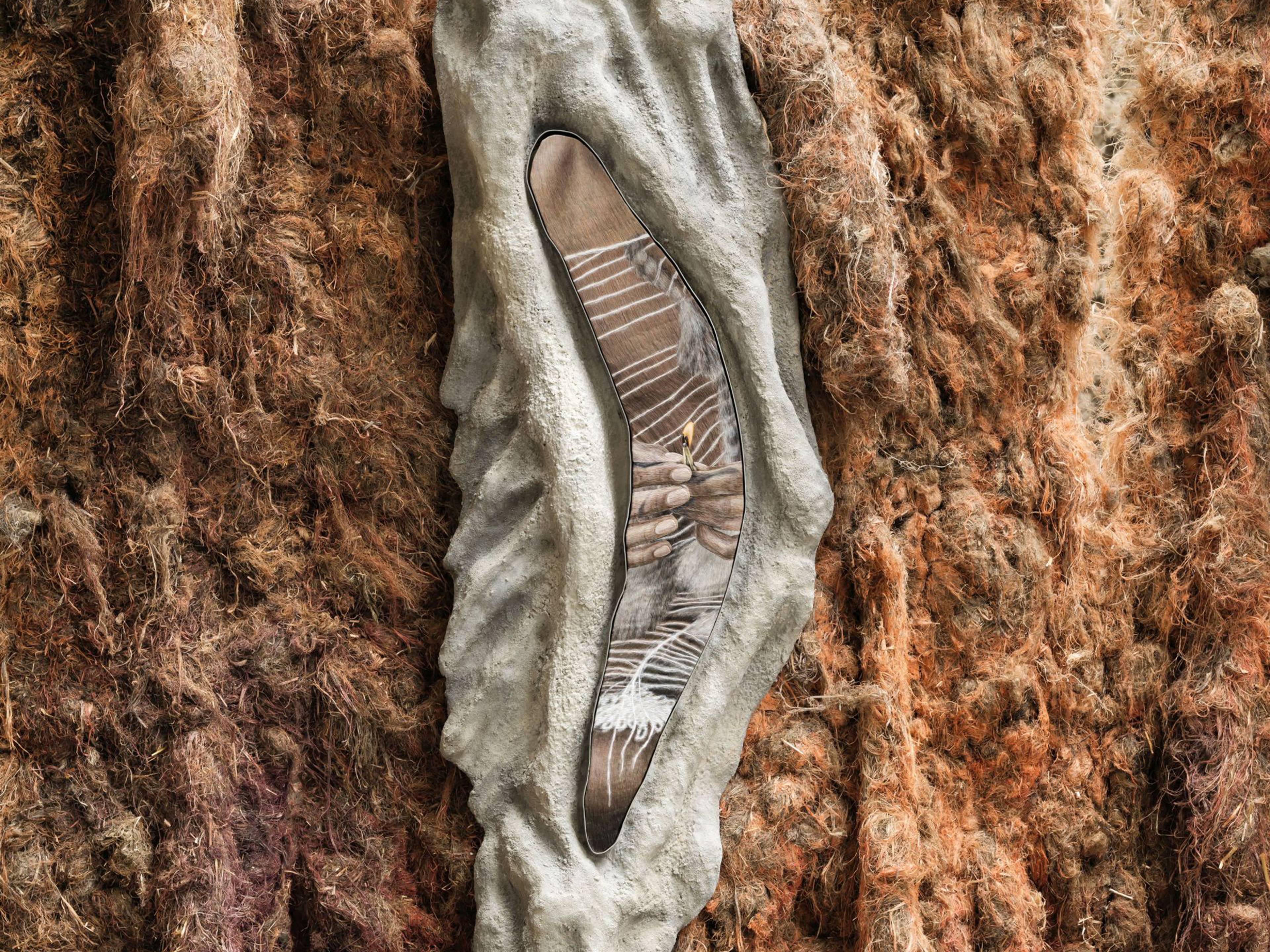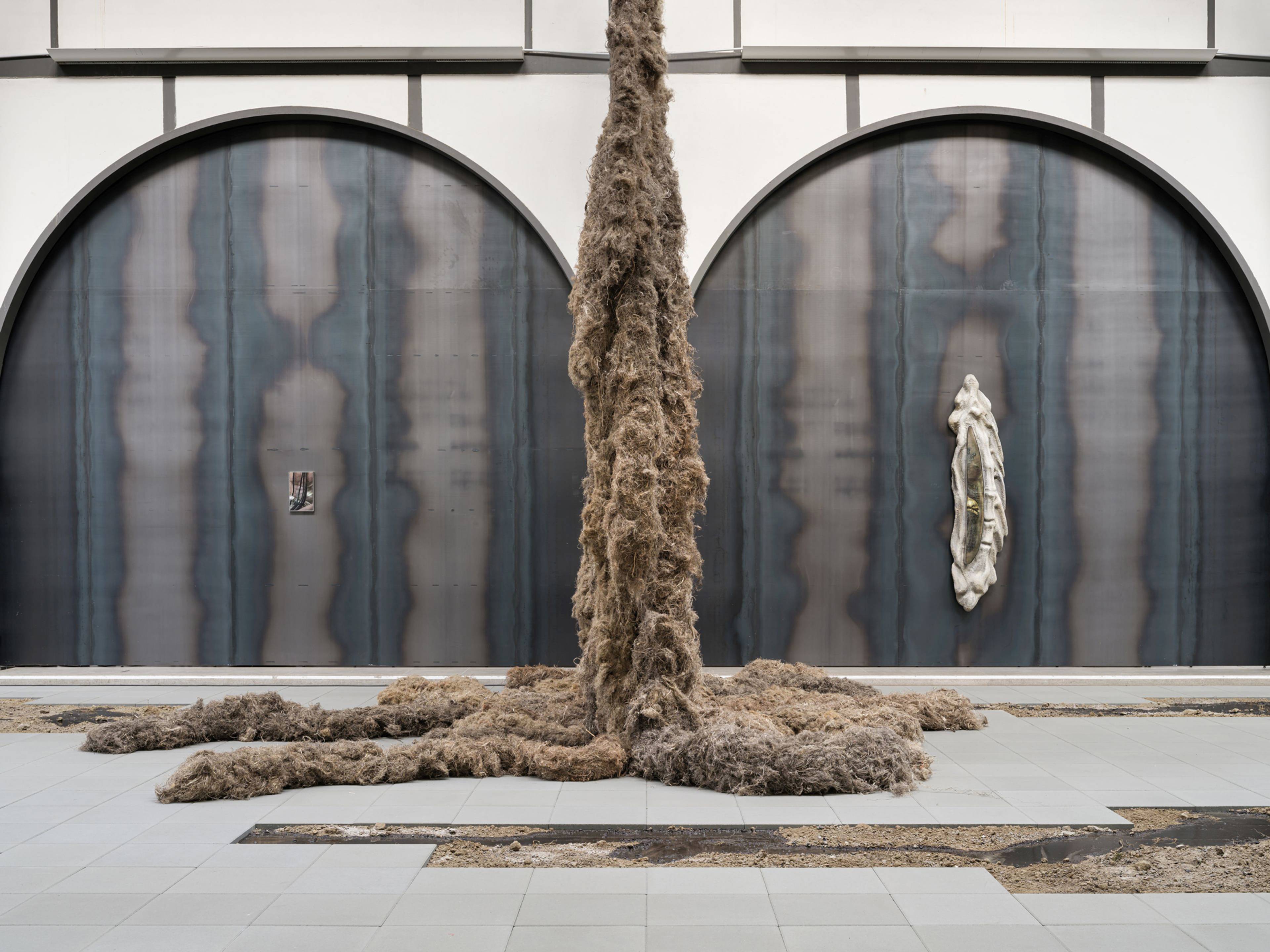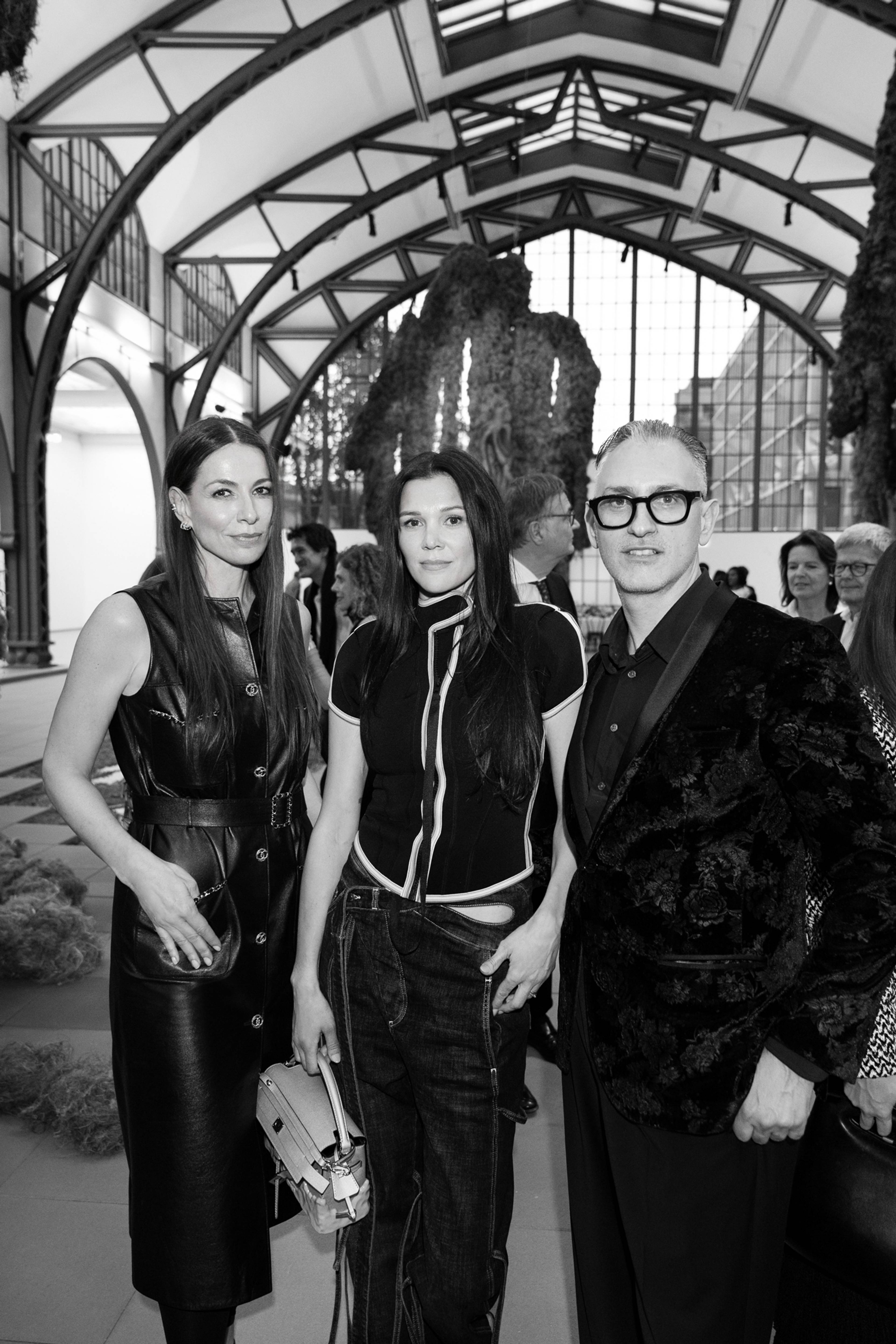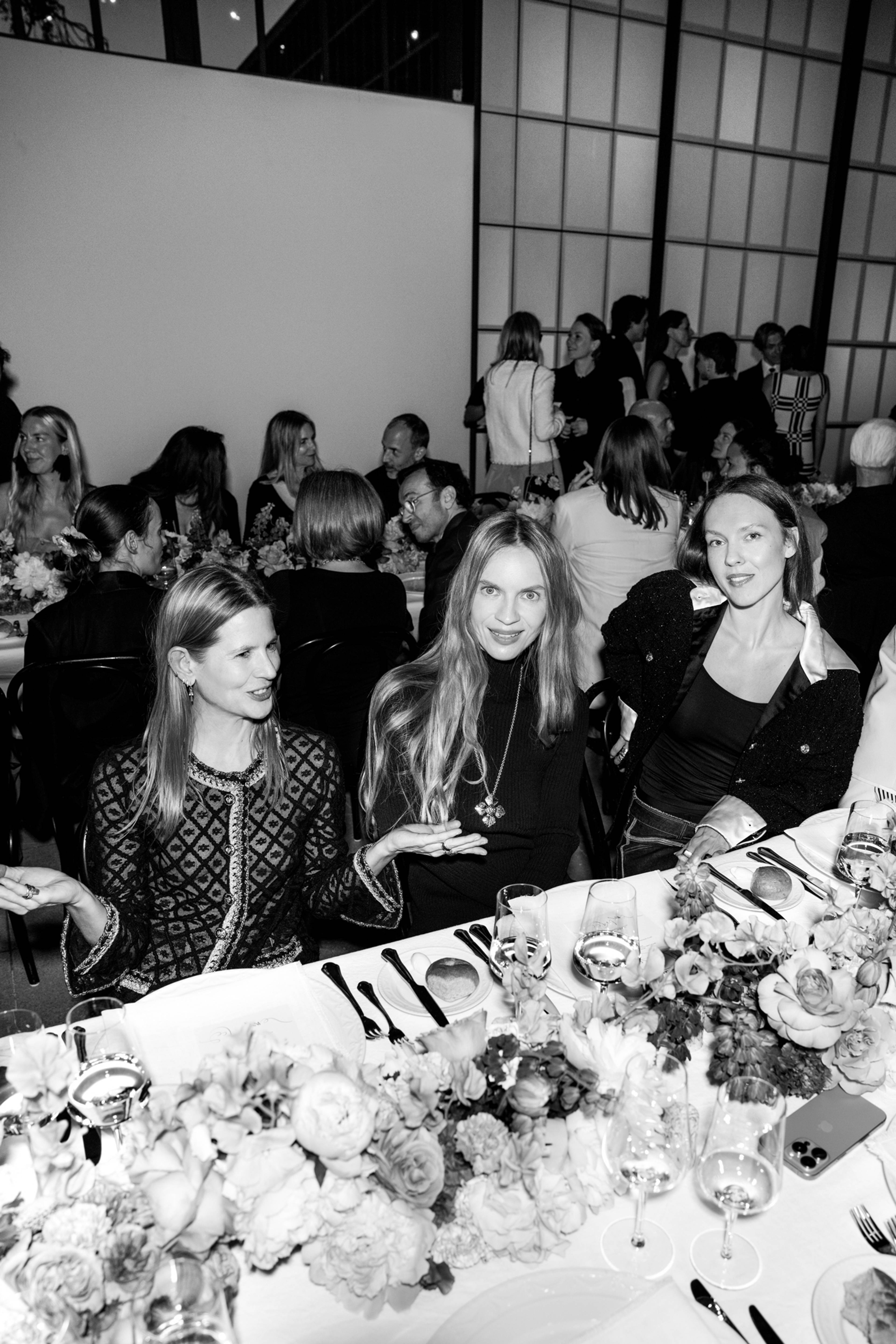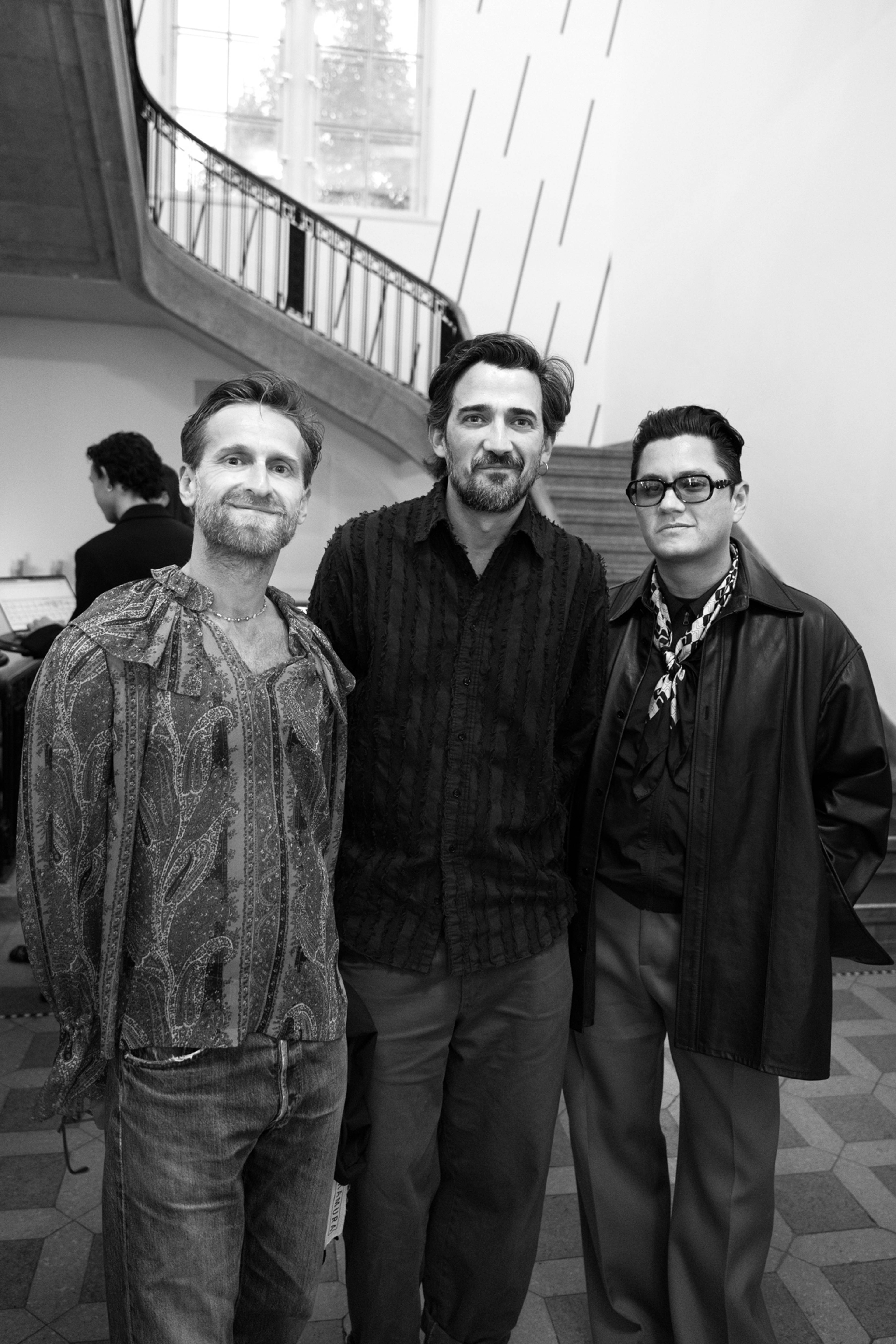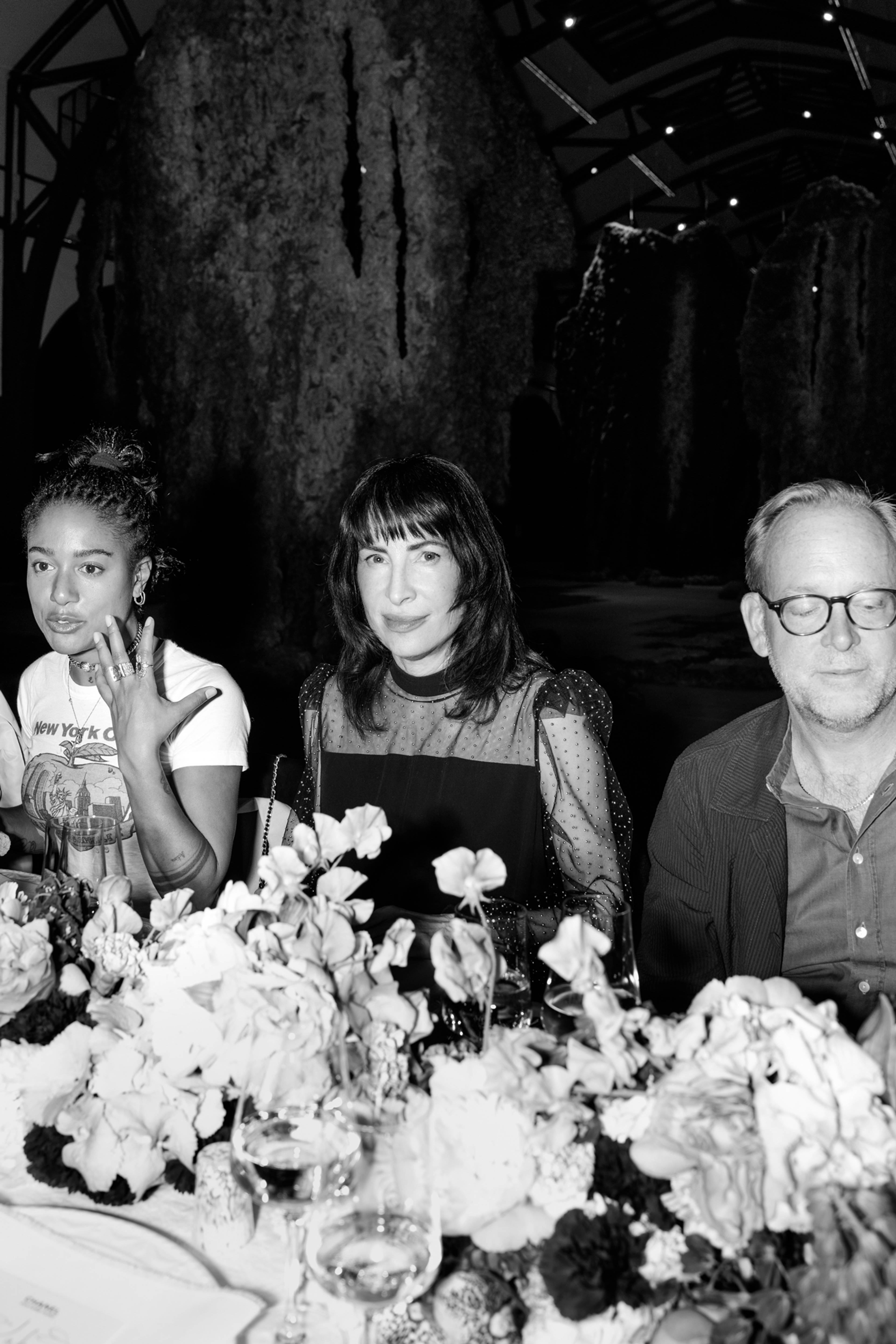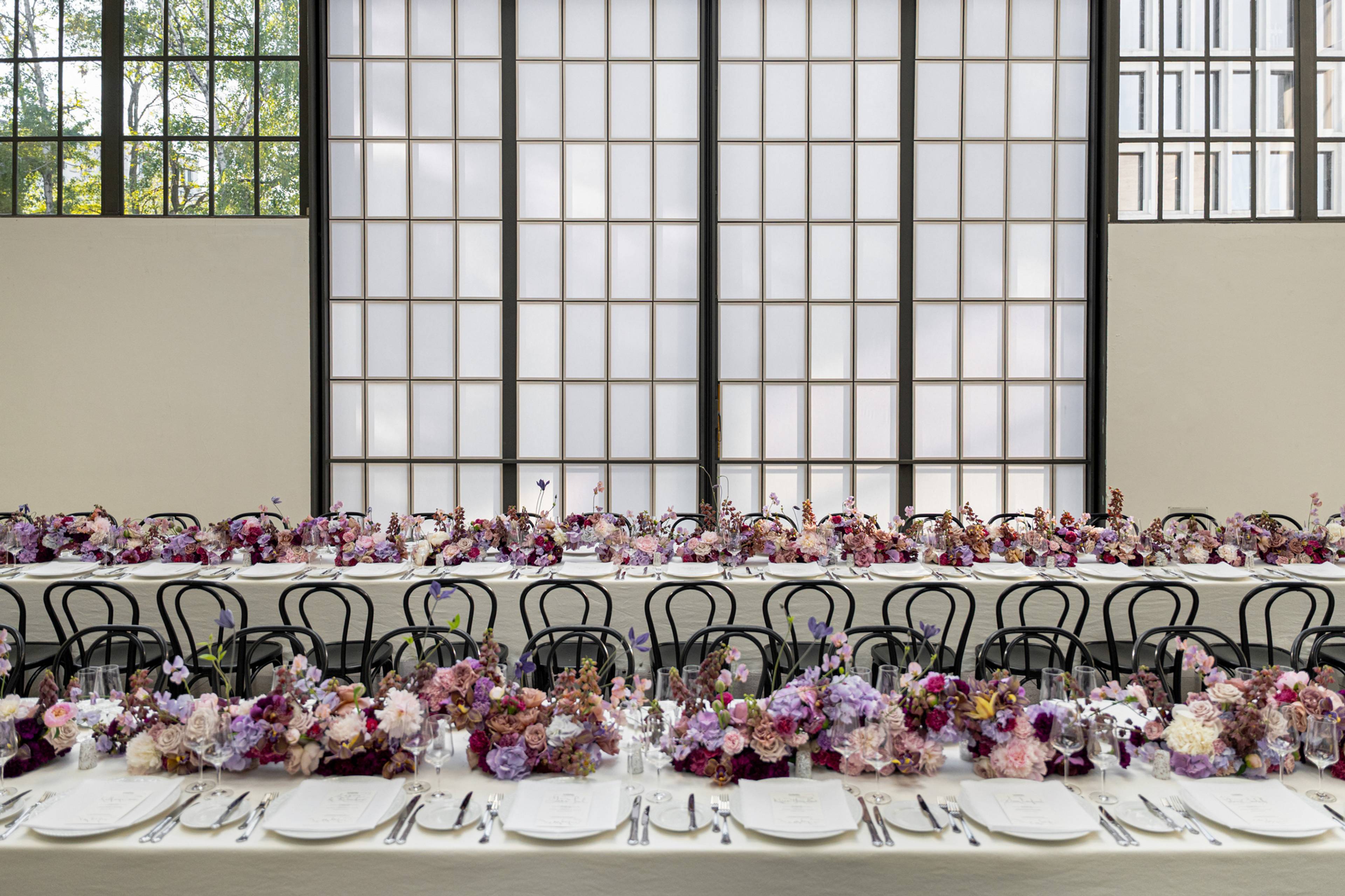There are a lot of names known but not met in blazers, sometimes heels, occasionally smiles. I’m missing the top button of my indigo chore jacket, the pockets too dowdily full to properly drape. I wish someone would ask where I got the teal and gold vest underneath so I could say “Baghdad” and when they’d say “Really?!” I could say “It’s the same colors as the Haydar-Khana Mosque, where a 1920 revolt …” but no one asks. I flag the one face in the room who will recognize my own and, helpfully, is unmissably tall.
The dinner for CHANEL’s inaugural commission at Hamburger Bahnhof, Berlin corrals us down the museum’s ship-like main hall, to a pair of staggeringly long tables, each Raphaelite-ly white-clothed and blushing all along their spines with pink flower heads: roses, carnations, orchids, also vetchlings (or peavines). I find my place marked in Art Nouveau scrawl, seated second from last but facing the exhibition space, already laid with roll. I start padding my butter just as Yana Peel, president of arts, culture, and heritage at the fashion house, rises at the head of the table with glass.
Views of the dinner opening “embrace,” Hamburger Bahnhof, Berlin, 2025
Photos: German Larkin (UNOPOSTPRODUCTION)
Her toast is to Czech artist Klára Hosnedlová (*1990), whose “embrace” has hung from the vaulted iron girders – at what Peel calls “epic scale” – showers of thickly dreaded fabrics, dyed beige and rust and moss, that plait into six upright, broad-shouldered titans. Part human, part monster, part phantom, these sentinels seem to float despite their weight, dozens of descending appendages coiling and unspooling over the re-slabbed floor. Here and there across the concrete spread puddles of water (clear epoxy) and scuzzes of dirt, as though the forest guardians – Tolkien’s ents, maybe, or the Slavic god Leshi – has pulled down the former train station’s skylighted roof. Sculpturizing the garden flora and woodland fauna depicted in so much folk weaving, Hosnedlová’s tapestries now stand watch.
A man with a Secret Service earpiece choreographs our first course, plated on glossy Prussian porcelain: a nest of delicate greens ribboned with slivers of cucumber, between two turrets of miso eggplant and a cupola of mildly tangy sauce. Over track versions of FKA Twigs’ Eusexua (2025) that beat like they’re being played outside the museum, my neighbor, who directs the residency program at a Berlin art college, and I flit between orders of the day, from the salad (wet), through “embrace” (Wunderschön), and onto immigration (Neukölln has changed so much). Their Oma fled the GDR when her dissident-ish cinema program started drawing attention from the party, with help from an East Berlin baker who cos-played her lover; she got over before the Wall. Now, their residency has been denied a visa for the first time (on behalf of an Egyptian artist), while the Berlin Senate has initiated deportation proceedings against four pro-Palestinian activists, including three EU citizens, absent criminal convictions (and over the objections of the state’s own immigration office).
Views of “embrace,” Hamburger Bahnhof, Berlin, 2025
Courtesy: the artist
Photos: Zden?k Porcal – Studio Flusser
I get up to smoke. On the front landing, a posthumous Dan Flavin paves everything blue; I find the most relaxed-looking person of my gender tonight and say hello. They’re opening a very leafy show tomorrow and are peckish for what’s after the salad. The wine is made from grapes carried six kilometers on foot from vineyard to winery over a car-free island in the French Riviera; it’s also France’s second national park. I don’t drink, but the tap water is cooly, perfectly tasteless, the water-pourers attentive.
I take several slow, solo walks among Hosnedlová’s vegetable-mineral-spiritual totems, stepping lightly between their root-y sprawl and the sort of dried out riverbed cutting up the floor. Several of the furs are woven in with hard forms like weathered bones, ridged vertebrae and webbed spines moulded into their gray, pocked resin. But the artist has also embroidered into the openings of several of these would-be fossils – homes once to eyes, perhaps egg canals – images of human hands: rinsing lank hair, stalking a butterfly with a flame, clearing a path through an ashy tattoo. I ask for the impression of one of the catering staff, who is also new to the installation. “An apocalyptic rainforest – a dystopia you can live in.”
President of Arts, Culture, and Heritage at CHANEL Yana Peel, artist Klára Hosnedlová, and Hamburger Bahnhof co-director Sam Bardouil
Theater-maker Aino Laberenz, musician Mary Komasa, and choreographer Franka Marlene Foth
Artist Petrit Halilaj, artist Alvaro Urbano, and curator José Esparza Chong Cuy
Singer Larissa Sirah Herden and Schinkel Pavillon director Nina Pohl
I sit down to sole fanned over a medley of seasonal vegetables, principally peas, the buttery sauce perfumed with minced dill and the nearby peonies. Fork by fork, I eat my way into a conversation about how electric Warsaw is, until I can ask: Is it like Baghdad during Eid? You can get detergent, a pair of shoes, a light fixture, maybe a car after midnight … A musician rolls their eyes disbelievingly. “It’s the new Berlin!” The set and costume designer seated between us, who has only coyly volunteered that they’re working on a film, notes that Neue Nationalgalerie director Klaus Biesenbach is gone – meaning, the rest of us may go, too, without touching bottom on our affogatos.
Sending us off is the evening’s second toast to Hosnedlová, from Hamburger Bahnhof co-director Sam Bardaouil. Growing up in Lebanon during the Civil War, he cut out photos from various magazines, collecting under his bed an atlas of the world he was cut off from. One day, his dad found the pictures and began hurling them into the air, apparently enraged by his child’s literal flights of fancy. Moved to tears, though, the elder Bardaouil intoned, “Son, you shouldn’t keep your dreams in a box” – an adage that, Sam claims, spurred his vocation into art, whose protagonists make real castles in the air. But inasmuch as the installation at his back moulds time, oneirically, as malleably as space – the capital-H History of mankind’s evolution now just one more current in an oceanic geological fabric – Hosnedlová’s intention doesn’t strike me as making-come-true. Rather, her work is itself a vision, of pulling, methodically but desperately, after a utopia receding in many directions, asking not to be filled like a vessel, but interpreted like a pattern, hand stitch by hand stitch.
Flower design: Anatomie Fleur, Berlin; tableware: Königliche Porzellan-Manufaktur, Berlin; linens: Chiarastella Cattana, Venice; calligraphy: Betty Soldi. Photo: German Larkin (UNOPOSTPRODUCTION)
“CHANEL Commission: Klára Hosnedlová. embrace”
Hamburger Bahnhof – Nationalgalerie der Gegenwart, Berlin
1 May – 26 Oct 2025
